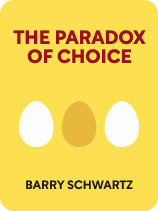

This article is an excerpt from the Shortform book guide to "The Paradox of Choice" by Barry Schwartz. Shortform has the world's best summaries and analyses of books you should be reading.
Like this article? Sign up for a free trial here .
Are you ever overwhelmed by choices and don’t know what decision to make? What tips can help you come to a decision that you’ll be satisfied with?
You’ve probably experienced this before: you’re starving, but you keep scrolling through delivery apps and can’t decide what to eat. Finally, you get so frustrated that you just give up and heat up some leftovers, or you just pick something at random. We’ve all been there—it’s called decision paralysis.
Here are 11 tips for how to make a decision when you’re overwhelmed by choices.
How to Cope With Expanded Choice
In his book The Paradox of Choice, Barry Schwartz lays out a series of recommendations for effectively dealing with being overwhelmed by choices. Each set of recommendations references an area of concern discussed in the book.
1. Be Selective in Your Choices
Schwartz’s first recommendation is to be selective when making choices.
When making decisions, he says the subjective result—how a decision feels to you—is more important than the objective result. There’s no need to choose from unlimited options because there’s no point in searching for the “best” option; doing so actually will make you feel worse. Because of this, reducing your options can help you to make decisions that feel better.
Schwartz recommends taking these steps toward reducing your choices:
- Review a few recent decisions.
- Consider the time and effort you put into these decisions. Did they cause you stress?
- Did you ultimately benefit from this decision-making process, or could you have made an equal or better decision with less deliberation?
By taking these steps, Schwartz says you’ll get a better sense of which decisions are necessary to you, how many options you need to consider, and how much energy you need to expend on any given decision.
(Shortform note: Another way you can learn to be selective in your choices is to make a habit out of narrowing your options to two, when feasible. Researchers from the University of Basel in Switzerland found that, even when presented with numerous options, people tended to focus on the two most appealing ones. Deliberately cutting your options to two can eliminate some extra thought and effort when making a choice.)
2. Deliberate, Don’t Guess
Schwartz’s second recommendation is to deliberate among options when making decisions, instead of making an uneducated guess.
Deliberating is the process of making decisions with thought and care. Guessing, on the other hand, is making a choice without any thought—simply picking from an array of options. Since we’re presented with an overwhelming number of choices, it can be easy to become a guesser, even for important decisions.
The process of reviewing your decisions, which we described earlier, helps you to determine which decisions should be carefully chosen and which can be guessed at without much thought.
Schwartz states that determining when to deliberate and when to guess will help you to:
- Abbreviate the decision-making process for decisions that aren’t important to you
- Have more time to consider what you really want when making more important decisions, since you’ll have saved time on these unimportant decisions
- Devise new options if those you’ve been considering are insufficient to achieve your goal
| How to Deliberate a Decision To come up with a good decision while also not overthinking it, revisit the steps Schwartz suggested in Chapter 1: -Determine your goal or goals. -Consider how important each goal is. -Lay out your options. -Evaluate how each option can advance your goals. -Choose the best option. -Based on how your decision turned out, use what you learned to adjust your future goals and how you go about meeting them. The Harvard Business Review offers an additional recommendation for making difficult decisions: Use a timer to give yourself time to deliberate while providing a deadline to make a final decision. |
3. Be a Satisficer
Schwartz’s third recommendation is to use satisficing as a decision-making strategy.
Schwartz has extensively discussed the downsides of maximizing and the upsides of satisficing. Maximizing is possibly the worst strategy to deal with expanded choice, since it both expends valuable time and energy and leaves the chooser unhappy. Satisficing, on the other hand, gives people the opportunity to stress less and make subjectively good choices.
If you have maximizing tendencies, Schwartz recommends taking three steps toward satisficing:
- Reflect on the situations where you already settle for “good enough.”
- Examine your decision-making process for these situations, as opposed to the situations where you maximize.
- Apply the satisficing process to more of your decisions.
| How to Satisfice Schwartz’s recommendations to identify the areas in which you already satisfice, then apply the process to more decisions, is likely the smoothest path to satisficing. You might also try incorporating the second-order method of setting standards to streamline decisions: determining what you generally require from your options. For example, if you’re planning a trip, you might set a standard of going somewhere warm, or if you’re buying a pair of jeans, you might set the standard of not paying more than $45. These provide you with a helpful limit, while also ensuring that you’ll be satisfied with your decisions. |
4. Don’t Obsess Over Opportunity Costs
Schwartz’s fourth recommendation is to resist obsessing over the opportunity costs involved in making a decision.
We need to know what our primary alternatives are in order to judge the decision we make. But we can run into trouble with opportunity costs if we dwell on them too much—for instance, turning over every single option repeatedly, or putting so much pressure on yourself to identify the “best” option that none satisfies you. For people who have this problem, Schwartz recommends limiting your consideration of opportunity costs, using these strategies:
- Unless you’re truly dissatisfied, keep making the same purchases that you typically would. Don’t seek out new things just for the sake of it.
- Be wary of advertising suggesting “improvements” to products that you haven’t had significant issues with.
- Finally, don’t worry about missing out. If what you have works for you, it’s sufficient.
| How to Limit Consideration of Opportunity Costs Schwartz notes that we often focus on opportunity costs when buying consumer goods—it can be tempting to always seek out new alternatives, because they have attributes that the things you already own don’t. Because of this, one way to limit considering opportunity costs unnecessarily is to be more deliberate about what you buy and when. Schwartz recommends making your purchases consistent and being skeptical of marketing suggesting that products have “improved.” One article also recommends being grateful for what you have, buying only what you need in the near future, and reminding yourself that not buying anything is fine. |
5. Make Firm Decisions
Schwartz’s fifth recommendation is to make strong decisions without looking back.
As mentioned, when we’re able to reverse decisions, we’re less satisfied with the decisions we make. Since we’re technically able to walk back the decision, it becomes tempting to perpetually scope out other options, neglecting the choice we’ve already made.
Schwartz recommends putting your energy into the choices you make, rather than waffling on whether you could’ve made a better choice. This is especially important when it comes to social and intimate relationships, since these require long-term effort.
| How to Make Firm Decisions Psychology Today offers these tips for sticking with your choices: 1. Trust that the choice you made was the right one. 2. Stop examining other options once you’ve made your choice. 3. Communicate your satisfaction with your choice to other people to make it feel more settled. |
6. Find Ways to Be Grateful
Schwartz’s sixth recommendation is to practice gratitude for the choices you’ve made.
Our choices are affected by the real or imagined alternatives that we compare them to. Because we’re always considering alternatives that could technically be better than what we chose, it can be easy to take our choices for granted.
Schwartz advises us to avoid this preoccupation with alternatives and dissatisfaction with our choices by actively practicing gratitude. If we reflect on something about the decision that we’re grateful for, we’ll feel happier with it.
Schwartz recommends starting a regular routine of practicing gratitude—for example, making notes every day of what you’re grateful for. It might not be instinctive at first, but starting a routine of gratitude can help to change your perspective.
| How to Practice Gratitude Besides writing down what you’re grateful for, here are some other ways to practice gratitude: 1. Express gratitude to your community by volunteering. 2. Verbalize your gratitude to loved ones. 3. Find gratitude for what you’ve learned from difficult experiences. |
7. Minimize Regret
Schwartz’s seventh recommendation is to reduce the impact of regret on your decision-making.
Excessive regret can cause stress in our decision-making and sometimes make us avoid decisions entirely. For those who struggle with regret, taking steps to minimize regret can ease the decision-making process.
Schwartz recommends taking these steps to reduce regret:
- Satisfice when making choices. Accepting “good enough” helps you feel satisfied with your decisions, instead of regretful.
- Reduce your options. When you have fewer to choose from, you can be more confident in your ultimate decision.
- Practice gratitude. Reflecting on the positive outcomes of your decisions can help you think more positively and reduce excessive regret.
| How to Minimize Regret To reduce regret’s impact on your life, it’s also important to accept that you’ll sometimes feel regret for the decisions you make. Here are a few tips on how to accept regret for past decisions and move forward: 1. Accept the circumstances your choice caused, instead of trying to escape them. 2. Show yourself compassion instead of blaming yourself. 3. Use what you learned from the decisions you regret to choose differently in the future. |
8. Adjust to Adaptation
Schwartz’s eighth recommendation is to accept hedonic adaptation as a natural effect of making choices.
As we’ve discussed, after we make decisions that excite us, we often end up disappointed when the excitement wears off. This adaptation is inevitable, and we can acclimate ourselves to it by remembering that pleasure gives way to comfort over time.
Schwartz recommends taking these steps to adjust to the process of adaptation:
- When you make a pleasurable new choice, always remind yourself that you won’t feel as strongly about it a few weeks or a few months down the line.
- Spend less time maximizing. If you make your decisions efficiently, you won’t feel the loss of pleasure as strongly as you would if you spent excessive energy on the decision.
- Again, practice gratitude. Even if life can’t be constantly exciting, there are always good things to embrace.
| How to Adjust to Hedonic Adaptation Another way to adjust to hedonic adaptation is to add small pleasures to your daily life. Doing little things like buying your favorite coffee, meeting a friend for lunch, or taking a walk in the park on a nice day can go a long way toward adding pleasure into your daily life, even if you’re losing pleasure in other aspects of your life. Finding new, ongoing hobbies can also help with hedonic adaptation. For example, you might try taking a dance class, learning to bake, or joining a book club. These can bring pleasure to your life over time, as opposed to material purchases that can only be enjoyable in the short term. |
9. Temper Your Expectations
Schwartz’s ninth recommendation is to set realistic expectations for the outcomes of your choices.
Our expectations shape whether or not we’re satisfied with our choices. If your expectations are sky-high, then it’s inevitable that you’ll end up disappointed sometimes. However, if you keep your expectations realistic, then you can feel more consistently satisfied with your choices.
Schwartz recommends taking these steps to adjust your expectations:
- Reduce your options. You’re more likely to be satisfied when you don’t have every possible option at your fingertips.
- Satisfice. Keeping reasonable standards and accepting “good enough” will keep your expectations high but realistic.
- Be open to happy accidents. The things that bring joy in life tend to be unexpected and infrequent. If your expectations are generally modest, then these special moments will be even more satisfying.
| How to Temper Your Expectations Lowering your expectations can be tough on a psychological level, particularly if you’re used to maintaining very high expectations. There are several strategies for easing into lower expectations, as outlined in this PsychCentral article. The first is simply to notice when you’re setting your expectations too high, as this can help you be consciously aware of it. You can also consider how high expectations have affected you in the past, be compassionate with yourself and others when choices don’t live up to expectations, and be flexible when setting expectations. |
10. Reduce Social Comparisons
Schwartz’s 10th recommendation is to make fewer social comparisons.
We make social comparisons every day to help us make choices and gain status. But, while common, social comparison typically makes us dissatisfied and unhappy.
Though social comparison is impossible to curtail entirely, Schwartz makes several recommendations for reducing it:
- Remember that just because someone seems to have more than you have, it doesn’t mean they’re better off.
- Prioritize your own happiness and satisfaction, not what you think happiness and satisfaction look like to others.
(Shortform note: Limiting how much social comparisons impact you can be easier said than done. One writer shares how she personally dealt with social comparisons: She gave a name to her “inner critic” in order to look at her social comparison impulses objectively, practiced self-care, and reflected on important achievements in her life.)
11. Embrace Constraints
Schwartz’s 11th recommendation is to embrace reasonable constraints on your freedom of choice.
When choices proliferate, they eventually start to control our lives. Even simple, routine choices can become challenging. So spending less energy and time on inconsequential decisions reduces stress and increases control.
Automating unimportant or second-order decisions helps us to prioritize more important decisions. For example, making decision rules and setting standards simplifies our decision-making. Ultimately, adding constraints helps us process the unprecedented array of choices before us.
(Shortform note: There are numerous ways to place reasonable constraints on your decision-making. In one article, psychologist Elizabeth Scott lists several different options. Some of these echo Schwartz’s recommendations, such as using second-order decisions like building routines. Scott also recommends turning to trusted role models and experts for difficult decisions and being willing to say “no” to requests from others that would require you to make more choices.)

———End of Preview———
Like what you just read? Read the rest of the world's best book summary and analysis of Barry Schwartz's "The Paradox of Choice" at Shortform .
Here's what you'll find in our full The Paradox of Choice summary :
- Why the more choices we have, the more stressed and indecisive we feel
- How to better navigate our choices, from groceries to health insurance
- Whether it's better to seek the best or accept "good enough"






